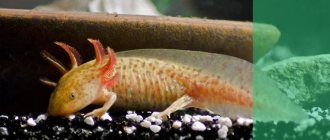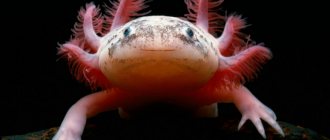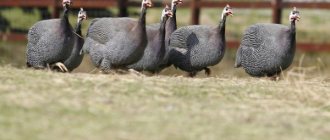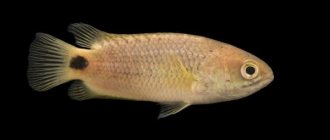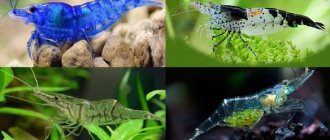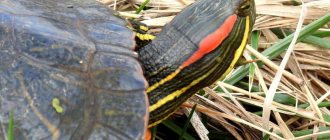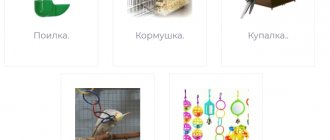The axolotl is an incredible, fabulous creature whose appearance resembles a prehistoric amphibian or newt. Because of such an extraordinary appearance, these individuals were nicknamed “water monsters” or “water dogs,” but not everything is so simple. An interesting fact is that it was the axolotl that turned out to be the prototype of the character of the popular cartoon “How to Train Your Dragon” - the dragon Toothless. Also, its original appearance inspired the creators of the image of the moon bee - Luntik. Axolotls are not only “terribly adorable”, but also unique - they are not a full-fledged animal - they are just a larva that never became an adult. What is this joke of nature, and what should future owners of this creature who decide to place such a miracle in their home aquarium need to know?
Description of individuals
Axolotl is not the name of a species of animal... In fact, these creatures are neotenic larvae of amphibians, most often of the Mexican or tiger variety of amphibians. The thing is that representatives of these species are more prone than others to neoteny, when the period of their development does not go through a full cycle, but individuals turn into adult specimens, remaining in the form of a larva, and at the same time can exist in this form.
Translated from Greek, “neoteny” sounds like “extended youth.” An amphibian, without undergoing metamorphosis, lives a long life cycle and is even capable of producing offspring. This feature is associated with the work of the animal’s “thyroid gland”. Surprisingly, if the larva is placed in other habitat conditions, the life cycle can be completed and it will turn into an adult ambystoma.
Externally, the axolotl resembles a fantastic dragon or an unusual toy - with a large head and gills sticking out. The description of the individuals is as follows:
- the body of the salamander, like that of adult representatives, has a head, torso and tail, the larvae do not have a bone corset, it consists of cartilage - fifty vertebrae, young individuals are especially soft;
- head – when compared with the body, it seems disproportionately large and expanded;
- the mouth is flattened, of a decent size, it seems that the axolotl is constantly smiling. The mouth contains tiny teeth, very sharp - individuals use them to hold prey, but they cannot tear food with them;
- eyes - tiny beads, black with a noticeable shine;
- gills - give amphibians a cosmic appearance, they look like pubescent branch-like shoots, extending from behind the head. Individuals are able to move them - press or shake them, clearing stuck debris;
- the body is narrowed, slightly flattened, streamlined in shape. There is a ridge-fin along the ridge; there are 16 grooves on the sides, due to which the newt looks “ringed”;
- skin – delicate, with a smooth surface;
- limbs - the axolotl has two pairs of legs, on the back - 5 fingers, on the front - one less;
- the tail is elongated, widened, makes up about 3/4 of the entire length; along its entire length there is a fin fold that extends from the back.
The size of the larvae varies from 15 to 30 cm, maximum weight is no more than 0.3 kg, girth is 13-20 cm. Males are larger than females and have a longer tail. There are quite large representatives (about 45 cm). If we talk about species differences, then the larvae of the Mexican Ambystoma have a flatter muzzle, a smooth body, and the color is not as variegated as that of the brindle.
Compatibility
Compatibility is an important issue in keeping any aquarium inhabitants, a question about which many copies have been broken, and axolotls are no exception. However, most owners keep them separately and for the following reasons.
Firstly , the external gills characteristic of axolotls make them vulnerable to attack by fish. Even calm and slow fish species cannot resist the temptation to try to bite them, and as a result, pitiful scraps remain of the luxurious shoots.
Secondly , axolotls are active at night and sleeping fish, in turn, become easy targets for them. It is almost impossible to find a middle ground between size (so that the fish does not get eaten) and aggressiveness (so that the axolotl itself does not suffer).
But there is an exception to every rule, which allows you to keep axolotls with fish. And this exception is goldfish. They are very slow, and if they are well fed, most will not even try to chase the axolotl.
Only a few will try, they will get a painful pinch and will stay away. Plus, keeping goldfish also requires low water temperatures, making them an ideal choice.
And yet, the safest way is to keep the axolotl separately, and one individual per aquarium. The fact is that they pose a danger to each other, young and small axolotls suffer from old and large ones and can lose limbs or even be eaten.
Overpopulation leads to the same consequences, when a larger individual kills a smaller one. It is very important to keep only individuals of equal size in a spacious aquarium.
Coloration of larvae
Mother Nature has not been stingy here either, so you can find creatures of various colors. The color of the larvae depends on the conditions in which they appeared - in nature or during artificial breeding, and on the quality of life. Axolotls are divided into three types based on color:
- "Naturalists" – black or dark (grayish, brown, brown, marsh-colored) individuals whose body is covered with spots. The pattern on the skin can be anything - in the form of a small, large, mesh-like pattern.
- White – are not albinos, the skin is uniformly light, and as the individual grows older, a patterned pattern appears on the back. There are not only pure white axolotls, but also pinkish, beige shades. The color of the gill petals is not red, but intense pink.
- Albinos – “albs” have no pigment, so they are completely whitish in color, there are no spots or patterns, the eyes and gill processes are bright red. Golden albinos are also found.
But these are not the only variations, since thanks to selection, axolotls with even more original colors were bred. Using GMOs, scientists were able to obtain individuals whose skin patterns begin to glow under fluorescent lamps.
Interesting Facts
- As a result of crossing axolotls with different genes, it was possible to obtain a species on the body of which, under the influence of a fluorescent lamp, luminous spots and patterns appear.
- The Aztecs used water dragons to make medicinal potions.
- In their natural habitat, representatives of different species of amphibians do not interbreed, but when kept in captivity they are capable of producing offspring.
- Axolotls are listed in the International Red Book as an endangered species.
Lifestyle and behavioral characteristics
Axolotls have several respiratory systems - they can use gills, lungs or skin to breathe. In a clean aquatic environment, individuals breathe with gills; in a dirty, with poor aeration, they breathe with their lungs, and partial atrophy of the gills occurs. But if larvae with atrophied gills are placed in favorable conditions, their “twig” processes will grow again.
The larvae have incredible regenerative abilities. They can restore almost all lost parts of the body, this applies not only to the gill processes, but also to the limbs, fins, and some internal organs. But adult ambystoms do not have such an opportunity.
The axolotl moves jerkily, raking with its front paws. But they are not as mobile as land ambystomas; most often they lie quietly and move only as needed. Usually individuals can be found at the bottom of a reservoir, where they lie, slightly moving their tail, or “hang” in the water, imposingly moving their paws. Periodically, these water dragons move their “twigs,” shaking off dirt from them. If you knock on the side of the tank, the occupant will swim away without any fuss.
Axolotl habitat in nature
The homeland of axolotls is the lakes and water canals of Mexico City. Dragons spend their entire lives in the water, never moving onto land. They prefer deep places with abundant vegetation, because their life largely depends on aquatic plants.
Axolotls are quite large representatives of the animal world.
During breeding, females attach eggs to aquatic plants, after which males fertilize them. By the way, the word “axolotl” translated from the Aztec language means “water monster.” Before the Spanish invasion began, the Aztecs ate dragons: the meat of these animals was considered medicinal, and the taste was similar to eel.
Video – Interesting facts about the axolotl
Habitat
In nature, these amazing creatures are very rare. They are representatives of an endemic species, as they live only in 2 Mexican lakes located in the mountains at an altitude of more than 2000 meters above sea level - Cholco and Xochimailco. Here, the Aztecs once built “floating” islands – “chinampas”, on which today ornamental vegetation is grown.
Chinampas are well irrigated, so they and the canals between them are excellent habitats for axolotls and adult amphibians; here they live and reproduce, maintaining the population.
Popular questions and answers
Before getting an axolotl, aquarists study a lot of information. They are mainly interested in questions regarding the lifespan, reproduction and cost of water dragons.
How long does an axolotl live?
Under natural conditions, axolotls live for about 10 years.
In captivity, if the aquarist has provided his pets with the proper conditions and care, ambisto larvae can live up to 20 years.
How to breed an axolotl
Axolotls reach sexual maturity at the age of 1 year, but it is better to wait until individuals are 2-3 years old.
Before breeding, the female and male are placed in different aquariums, keeping them separate for several weeks. In this case, the usual water temperature must be lowered by several degrees. During this period, the larval diet should contain food high in protein.
Afterwards, the axolotls are transferred to a special spawning aquarium. The male deposits spermatophores, and the female collects these clumps of sperm using the cloaca.
A day after fertilization, the female aquarium dragon begins to lay eggs. As a rule, it attaches the eggs to the leaves of algae. At one time, a female axolotl can produce up to 1000 eggs.
After laying eggs, the parents are removed, and the temperature in the aquarium with the eggs is raised to 22 °C. After two weeks, fry hatch from the eggs.
Aquarium keeping of axolotls
These unusual inhabitants found their way into the home tanks of domestic hobbyists and collectors back in the mid-19th century. As it turned out, axolotls are quite unpretentious; they reproduce well in captivity, are omnivores and do not require painstaking care. This arouses even more interest in them and increases their popularity.
In medical laboratories, axolotls were often used to study the regenerative abilities of tissues, so many individuals raised in captivity are laboratory animals.
Feeding
What does axolotl eat? It is enough to simply feed, since axolotls are predators and prefer animal food. The size and type of food depends on the individual, for example, they eat well sinking food for predatory fish, available in the form of granules or tablets.
In addition, the owners provide pieces of fish fillet, shrimp meat, chopped worms, mussel meat, frozen food, and live fish. True, the latter should be avoided, as they can carry diseases, and axolotls are very predisposed to them.
The feeding rules are the same as for fish - you cannot overfeed and leave waste in the aquarium, as such food immediately rots and instantly spoils the water.
Mammalian meat cannot be used as food, since the axolotl’s stomach cannot digest the protein contained in it.
A suitable home for an aquatic “monster”
As practice has shown, these creatures can not only exist in captivity, but also live for a long time, giving birth to offspring. Naturally, if only the owner provides him with suitable housing.
How many reptiles can you keep in one tank?
It is best to place only one individual in one tank - salamanders, especially those of different ages, do not get along well with each other. For example, seasoned, large males offend young brothers, even to the point of injuring and eating them. As a last resort, amphibians of the same age and size can be kept in one container.
Tank size
A 50-liter aquarium is suitable for 2 individuals. However, when they reach their maximum size, this volume will only be enough for one axolotl. So it’s better to immediately place a couple in a 100-liter container or prepare for the pets to soon move to spacious apartments.
Water requirements
Until the quality of the water approaches natural, it is not recommended to place newts in it. It must be clean, although these creatures are able to survive in a polluted environment. You should be careful when choosing a filter - powerful devices that work constantly will frighten the inhabitants. It is better to purchase an internal filtration system that contains a sorbent and creates a weak flow.
You should keep the tank clean by removing leftover food and changing the water by about a quarter 1-2 times a week. It is recommended to carry out a complete replacement no more than 3-4 times a year. Water temperature is very important for these creatures. Since in nature they live in high-mountain lakes with cool water, living in a warm water environment is detrimental for them. The indicator should be no lower than 13° and no higher than 20°C; when it increases, individuals become ill and even die.
To monitor temperature stability, it is recommended to equip the container with a thermometer. During hot periods, it is necessary to take care of cooling the aquatic environment; for example, you can place a container with frozen water in the aquarium and replace it periodically. If possible, a tank with amphibians can be placed in the basement.
Soil material
Salamanders need it because when moving they cling to it with their limbs. If the bottom turns out to be without soil, the inhabitants may become stressed and ulcerations may appear on their paws. The use of pebbles, gravel and sand is not recommended; axolotls often swallow them, which leads to problems with the gastrointestinal tract. It is best to cover the bottom with a layer of pebbles large enough so that their particles do not fit into the amphibian's mouth.
Decor
It should perform not only decorative functions, but also provide shelter for these creatures. The number of secluded places should be greater than the number of inhabitants, each larva should have a choice. It is important that objects do not have sharp corners that can injure the delicate skin of axolotls. You can decorate the aquarium with driftwood, houses and ceramic figurines, arches, clay pots, halves of coconuts, etc.
Suitable aquarium location and lighting
Do not place the tank in places where direct sunlight penetrates, or next to devices that make noise - computers, televisions, musical equipment. Axolotls are nocturnal inhabitants, so they do not need any lighting; they feel more comfortable in the dark.
Caring for pet dragons is not difficult - you need to feed them, clean their home once a week and maintain the temperature. If it becomes necessary to move your pet to another tank, you should use a soft fabric net and proceed carefully. We must not forget that the larvae consist of cartilaginous tissue.
Keeping at home
Back in the middle of the 19th century, domestic hobbyists, as well as collectors, began to actively breed these unique amphibians, unpretentious to the conditions of their detention, as well as to food. In addition, they reproduce well. They are very popular and are happily kept in captivity, since their behavior does not cause any concern to their owners.
Interesting fact! These animals were kept in large numbers in various laboratories, where research was carried out on them and experiments were carried out on the subject of tissue regeneration.
Choosing an aquarium
It is quite natural that the size of the aquarium depends on the number of individuals that are supposed to be kept. In fact, it is better to keep each individual in a separate container, since adult individuals get along quite poorly with each other. This is especially true if these creatures are of different ages. Stronger adult males often bully their smaller and weaker counterparts. They can inflict many wounds on them, and sometimes they simply eat their younger fellow tribesmen.
Important to remember! Individuals of different sizes should not be kept together. If it is customary to keep them together, then they should be of the same age and approximately the same size. In this case, the aquarium should be such that it is spacious.
A container with a volume of about 50 liters is suitable for keeping two young axolotls. As you grow older, you should increase the volume of the container, eventually bringing the volume to 100 liters.
Aquarium equipment
In order for a newt to feel comfortable in an aquarium, it is necessary to create living conditions for it that are close to natural ones, and not simply by releasing the animal into a container of water. These unique creatures love to have a huge amount of cover to hide in, as well as some ground. Therefore, there are some factors to think about.
Priming
The presence of soil is necessary because they cling to it when they move from place to place. The absence of this leads to stress, and ulcers may appear on the paws. In this case, the presence of sand, and even more so small pebbles (gravel), is undesirable. They constantly swallow them, which leads to problems in the digestive system. Stones that animals cannot take into their mouths in the aquarium will not hurt.
Shelters
The presence of shelters in the aquarium will play a dual role: firstly, they will decorate the aquarium, and secondly, they will create a comfortable living environment for the pet. The number of shelters should be such that there is enough for all individuals with a reserve so that each larva can find a house for itself. The most important thing is that all objects inside the aquarium do not have sharp edges, since the skin of these creatures is very delicate. In the aquarium you can place:
- Wooden elements.
- Various ceramic figurines.
- Stones of different sizes.
- Arches.
- Pots.
- Coconut shell halves.
Aquarium placement
These amphibians are more active at night, so very illuminated places are not suitable. In addition, you should not place the aquarium near noise sources such as a TV or computer. There is no need for a backlight lamp either.
Axolotl is tame. Aquarium for a new pet | Axolotl in aquarium.
Water requirements
Naturally, it is better if there is clean water in the aquarium, although this does not matter for axolotls. Rather, this is important for the owner, because who is interested in looking at an aquarium in which the water is dirty, which does not allow observing the life activity of such “newts”. If you use noisy external filters, this will create some discomfort for your pets, since they work constantly, creating noise. The best option is to use an internal filter with a sorbent inside, which works with low water movement. Despite the non-critical conditions, it is better to keep the aquarium clean by regularly (daily) removing food debris and adding fresh water. A complete water change will be needed a couple of times a year, if you keep it clean.
Important information! It is very important for axolotls to create the correct temperature regime, since the larvae do not feel comfortable even at a water temperature of 21 degrees - it is too warm for them. At higher temperatures, the larvae can get sick and even die.
The aquarium should have a thermometer, which will allow you to control the water temperature, which should be between 13 and 20 degrees. When the room is hot, you will have to take measures to cool the water. This can be done using a plastic bottle in which water is frozen in the freezer compartment of the refrigerator. By empirically monitoring the water temperature, you can determine how often you should replace your water bottle. In fact, during the summer, it is permissible to move axolotls to live in a basement or cellar.
Care and maintenance
With the right approach to the problem, caring for axolotls does not contain anything complicated. Care comes down to organizing a proper diet, removing leftover food every day, and also monitoring the temperature of the water.
You should always remember that water dragons have no bones and their body is quite soft and delicate, so they must be handled with care. If you need to transplant a dragon into another container, you should use a soft net made of soft fabric. Dragons attacking each other, as a rule, occurs when there is a lack of food supply. Therefore, animals should be well-fed, but they should not be overfed. The reproduction process requires taking certain measures, which will be discussed a little later.
What to feed an axolotl
Ambystoma larvae, like all amphibians, are predatory animals, so to feed them you should use animal food in the form of bloodworms, which aquarium fish feed on.
Important to remember! You should not give food in excess, since animal food left uneaten in the aquarium quickly pollutes the water in the aquarium.
In the absence of bloodworms, the larvae can be offered an earthworm, pieces of fish or shrimp, mussels, insects, but without wings. These types of food create a number of problems when feeding, since axolotls prefer live, moving food. Granulated food for predatory fish may be suitable for feeding the larvae. Slowly descending, they create the appearance of movement, so the predator tries to grab it until they reach the bottom of the aquarium. In no case should you feed the larvae animal meat, since the amphibian digestive system is not designed for this. Food that has fallen to the bottom of the aquarium can be removed immediately, since the dragons will not see it, since their eyes are directed upward. If you immediately clean the aquarium, this will prevent spoiling the water in the aquarium in the future. If non-live food is used, it is better to offer it to pets using tweezers or feed axolotls by hand. Their jaws are designed to hold food objects, so the food is absorbed whole with the help of a wide mouth. So that the food has time to be digested in the larva’s stomach, it is fed once every 3 days. The larva will eat as much as food is offered to it, stocking up on food for future use, so it is very important to stop in time. Axolotls survive without food for 2 weeks, or even three: these are quite tenacious larvae.
Axolotl breeding
These creatures reproduce without problems in captivity; all that remains is to distinguish the male from the female. To do this, you need to turn the animal over and evaluate the cloaca area. If it is more convex and as if swollen, then it is a male. Females do not have this feature, but they are not much wider than males. The beginning of the mating season is characterized by an upward change in water temperature. In captivity, this factor is easy to achieve at any time of the year.
Interesting moment! Before the process of reproduction, the larvae need to be kept for several days from hand to mouth at a water temperature of about +10 degrees, and separately. Then they are placed together in a container with water heated to a temperature of +18 degrees.
To carry out the mating ritual, the larvae will need a lot of space, so a spacious aquarium will never hurt. The male releases seed into the water, and the female lays unfertilized eggs or sucks up clumps of seed with her cloaca. After about a day, the female will begin to hang eggs on various objects or plants in the aquarium. After this, it is better to remove the male from the aquarium, otherwise he may eat the entire clutch of eggs. It is better to maintain the temperature at the limit, about 20-21 degrees. When whitish or gray eggs appear, they must be immediately removed from the aquarium so that they do not infect other eggs.
After 2-3 weeks, from the pea-sized eggs, fry similar to fish are born. The body length of these fry is a couple of centimeters. The fry do not yet have limbs, which appear at different periods of time. After 1 week, the hind legs appear, and the front legs only after 3 months. The offspring that are born are first fed with ciliates, then with daphnia, small bloodworms, and also with special food for fry in a concentration of 1:4. As the fry grow older, they are gradually transferred to feeding with adult food. Eggs and fry need clean water for their development, which should be changed every day.
The female can be inseminated 2-3 times a year, but males can be used much more often to reproduce their own kind. At 10-11 months of life, the larvae become sexually mature, although the peak of fertility occurs at the age of 2-3 years. Having reached the 6-year threshold, individuals reproduce much worse.
How and what to feed the larvae with ambyst
In this regard, they are no different from other amphibians and are also predators, so it is best to feed them with live diets, for example, bloodworms, which can be purchased at a pet store. It is advisable for the owner to take into account the needs and characteristics of these amphibians:
- Individuals cannot be either starved - they become overly aggressive - or overfed - this negatively affects their health and water quality.
- In addition to bloodworms, they can feed on earthworms, chopped raw fish, mussels, small crustaceans, and insects without wings.
- In order for axolotls to be interested in prey that does not move, they will have to tinker - they are given to pets by hand or using tweezers.
- The menu can also include granules intended for feeding predatory fish. They slowly settle to the bottom, and predators manage to grab them at this moment.
- You cannot feed the larvae meat; their stomach is not designed to digest it.
- When feeding, you should take into account the visual characteristics of the “dragons” - they look only up, so they do not notice the food at the bottom. Anything that has settled must be removed from the tank immediately.
These creatures use their jaws to hold live prey, and then suck it in and swallow it whole, so adult individuals are fed no more than 2-3 times a week, so that what they eat has time to be digested.
Axolotls themselves do not know when to stop and can eat endlessly, “in reserve,” so it is important to control the size of portions and the frequency of feedings. In addition, they are so tenacious that they can endure even 2-3 week hunger strikes without tragedy.
Diseases and their prevention
Axolotls develop a number of diseases from poor nutrition: intestinal obstruction, anorexia, and pathology of cartilage tissue.
Intestinal obstruction develops when the amphibian swallows large grains of sand and pebbles. As a result, she stops eating and rapidly loses weight. In this case, a veterinarian examination and possibly surgery are necessary.
To avoid this situation, it is better to cover the bottom of the aquarium with large pebbles that the animal cannot swallow.
Pathology of cartilage tissue develops from a lack of calcium and vitamin D. Here you need to adjust the axolotl’s diet so that along with food it receives the necessary vitamins and microelements.
Anorexia in axolotls occurs from poor nutrition, as well as from infectious processes that occur in the body. For example, from intestinal parasites. The water dragon refuses to eat and its body swells. To cure the larva, experts recommend feeding it with ground egg yolk and granulated flower pollen.
Attention!
If the water is dirty and has a high chlorine content, the axolotl may develop ascites. Due to bacteria entering the body, the animal's metabolism is disrupted and it may die.
During treatment, it is better to place the sick axolotl in a separate container. The doctor will prescribe the necessary antibiotics, diuretics and other necessary medications.
It is also not recommended to constantly handle the axolotl. His body is tender and soft, there are no bones in it. Therefore, it is very easy for an aquarium dragon to be injured.
Many people wonder: what to feed the axolotl so that it does not get sick, what diet should it be given so that it has enough all the microelements.
Axolotls feed on bloodworms and live crickets. They will not refuse fish fillets and shrimp meat.
Pet stores also sell balanced food for amphibians, which axolotls readily eat.
Ambystoma larvae need to be fed once every 3 days.
Features of reproduction
It is not difficult to obtain offspring of aquatic dogs in aquarium conditions. And to distinguish the sex of individuals, it is enough to look at their cloaca - in the male it is convex, as if swollen. Females look thicker and wider in girth. The larvae reach sexual maturity at 10-11 months of age. The signal for individuals to mate is a change in temperature – a slight increase in the indicator and a decrease in lighting. These conditions can be provided to the larvae, regardless of the season.
If the owner plans to breed pets, then it is recommended to separate the couple from each other for several days, while providing them with a decrease in temperature to 10-12 degrees and a meager diet. And then they are placed in a tank with water having a temperature of about 18°C, and the following is expected:
- the male begins to perform a mating ritual, for which he will need free space;
- he begins to release the seed in the form of clots, and the female lays unfertilized eggs on them and, using the cloaca, absorbs the seminal fluid with eggs;
- 18-30 hours after this, the female hangs eggs on leaves of vegetation and other objects;
- as soon as spawning is completed, the “father” should be removed from the tank, since he will not disdain to feast on his own offspring;
- the water temperature in the aquarium should be moderate - 20°-21°C;
- You should periodically remove unhealthy - whitish or grayish - eggs;
- after 14-21 days, 2-centimeter pea-sized fry, resembling fish, appear from the eggs. Initially, babies do not have legs; the hind ones appear after 6-8 days, and the front ones only after 12 weeks.
At first, the offspring should be fed with ciliates, and then switched to daphnia, small bloodworms and special food for fry - 1/4 of the total diet. The water in which the fry live is changed every day, taking care to keep it clean.
The next insemination should be planned no earlier than 8 weeks after the previous one. But it is recommended to obtain axolotl offspring from one female no more than 3 times a year. It is useful for the male to inseminate eggs more often. The greatest fertility of individuals occurs at 2 years of age, but dragonets older than 6-7 years are not so successful in reproduction.
What does axolotl eat?
Photo: Axolotl at home
Young amphibians use small mollusks, crustaceans and other ciliates as a food source.
Mature individuals happily eat:
- larvae;
- earthworms;
- snails;
- cyclops;
- dophnium;
- crickets;
- mussels;
- bloodworm;
- paramecium;
- meat;
- fish.
Important information. When kept in aquarium conditions, it is not recommended to feed water dragons with amphibian meat. This product contains a large amount of protein, which is not absorbed by the axolotl’s digestive system.
You can use types of food that are intended for predator fish. In aquarium conditions, this is the most acceptable option, since it is not advisable to simply throw insects into the water for predators, because they need an imitation of hunting. Ready-made food has the ability to slowly sink to the bottom. Thanks to this, the water dragon has time to absorb it before sinking to the bottom. If you prefer to feed them non-living insects, it is better to do this with tweezers, since the axolotl uses its jaws only to fix a food source that is moving.
If food falls to the bottom of the aquarium and the amphibians do not have time to eat it, it must be removed immediately so that it does not pollute the aquarium or spoil the quality of the water.
The main source of food in natural conditions is zooplankton, small fish, and insects that live in the aquatic environment. It can easily feed on the limbs or other parts of the body of its fellows. To get them, the axolotl hunts. It chooses a secluded place for an ambush, catches the direction and rhythm of water flows, and when a potential victim approaches, makes a sharp lunge in its direction and grabs it with its wide open mouth.
These amphibians do not chew, so they swallow food completely. The process of digesting food takes several days. In the absence of a food source, water dragons can easily exist without food for several weeks, and still feel quite comfortable.
Who do these underwater inhabitants get along with?
Ambistoma larvae and aquarium fish cannot coexist in the same tank: axolotls will actively hunt small neighbors, and suffer from large ones - predators will attack them or tear their appendages. It will also not be possible to have a peaceful neighborhood with turtles and other aquatic inhabitants; the main reasons for this are incompatible nutrition and the likelihood of mutual aggression.
In addition, not all creatures can live in such a cool aquatic environment, and some representatives have common diseases. The only possible companions for axolotls are goldfish; they are too large to become food for newts and prefer to live in cool water.
Varieties
In nature, there are more than 30 species of ambisto. The most common are Mexican and tiger ambystoma.
Tiger Ambystoma Axolotl
Tiger Ambystomas live on the shores of reservoirs from Mexico to Canada. Their length, including the tail, is 28 cm. The skin color of the amphibian varies from dark brown to olive green. Yellow stripes are scattered throughout the body, hence the name “brindle”.
Tiger axolotls are often kept as aquarium pets. Albinos, individuals that were bred artificially, are very popular.
Marbled axolotls
A distinctive feature of marbled ambistos is their strong build and silver stripes on black skin. This species of ambistom does not grow more than 12 cm.
Marbled axolotls undergo a full transformation cycle in 2-6 months, depending on environmental conditions. They feed on daphnia, cyclops and other zooplankton.
Mole-shaped Ambystoma
These are one of the smallest ambistos. Their size is only 9 cm. Their tail is short. The head is wide and flattened. Almost all the time, the bloody ambystoma is busy digging the ground. Hence its name.
Pacific Ambystoma
And these are large amphibians. Their body length can reach 34 cm. They hunt snails and slugs, other amphibians, and also like to eat small rodents.
They live in deep burrows, where they hide from heat and bright light. When in danger, they make sounds similar to a growl. They can also bite painfully.
Olympic ambistomes
Named after the place where they live, the Olympic Peninsula, Washington State. They live on the banks of mountain rivers, in places covered with moss and shaded by coniferous trees. In rainy weather, Olympic Ambistos can be seen far from the reservoir.
The larvae of this species of Ambystoma settle in reservoirs with a rocky bottom.
Olympic ambystoms feed on beetles, flies, and earthworms.
The skin color of these amphibians is yellow, with small brown spots that cover almost the entire body.
Mexican Ambystoma
The most common type of ambistom. Lives in the lakes of Mexico. The adult is black or black-brown in color. This shade helps it blend into the bottom of the reservoir, hiding from enemies or hunting prey.
The larva of the Mexican Ambystoma is the black axolotl, which became the progenitor of many species of ornamental axolotls. It is this larva that can most often be seen in home aquariums.
